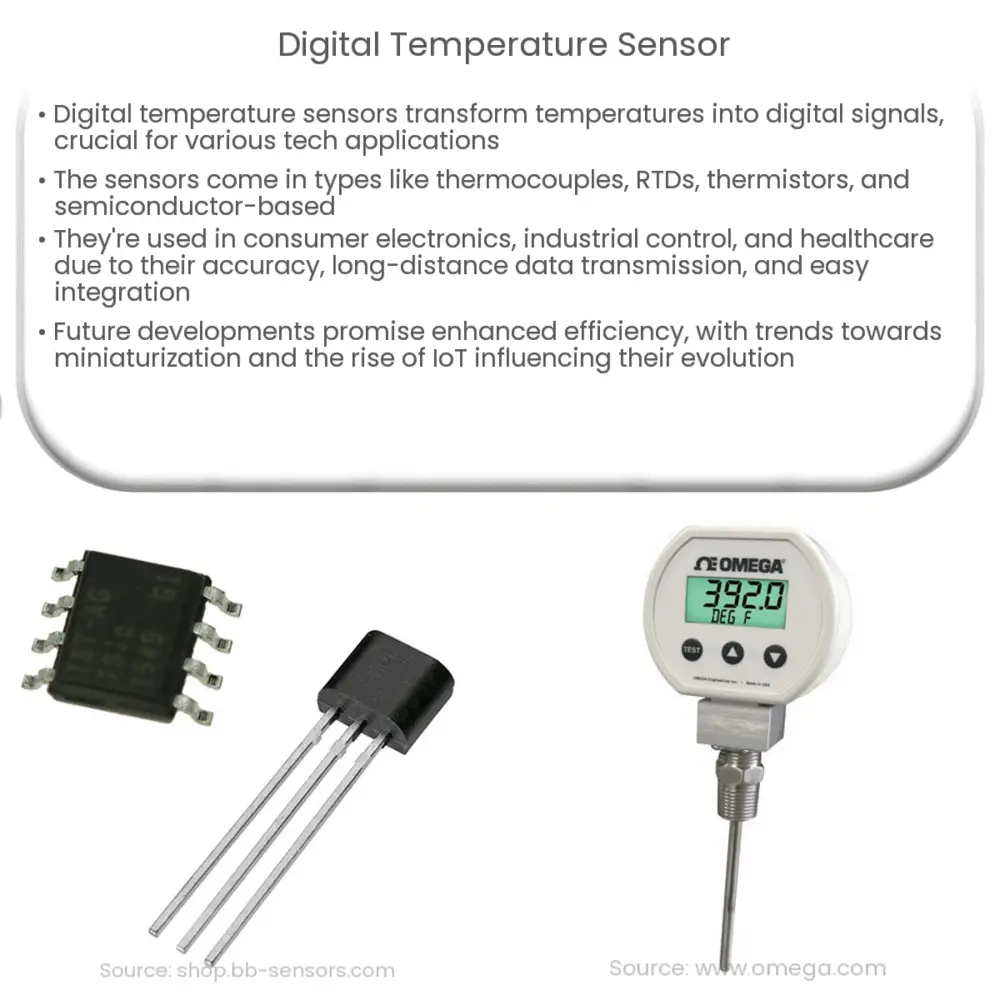Explore the world of digital temperature sensors, their types, working principles, applications, advantages, and future prospects.

Understanding Digital Temperature Sensors
Digital Temperature Sensors are crucial components in the realm of technology, playing an integral role in myriad applications. These sensors convert temperatures from absolute zero and above into a digital signal that computers can comprehend, enabling temperature monitoring in diverse systems.
Types of Digital Temperature Sensors
- Thermocouples: These are popular digital temperature sensors that function based on the Seebeck effect. When two different metals are connected and one junction experiences a different temperature than the other, a small voltage is generated.
- Resistance Temperature Detectors (RTDs): RTDs work on the principle that the resistance of a metal increases with temperature. They are known for their precision over a wide temperature range.
- Thermistors: Similar to RTDs, thermistors also operate based on resistance changes with temperature. However, they use ceramic or polymer instead of metal and are typically more sensitive than RTDs.
- Semiconductor-based sensors: These digital temperature sensors use the principles of semiconductor physics. The temperature-dependent voltage or current changes in semiconductor junctions are used to measure temperature.
Working Principle of Digital Temperature Sensors
The working principle of a digital temperature sensor varies depending on its type. However, the fundamental concept involves the sensor sensing ambient temperatures and producing a corresponding output. The output is then converted into a digital form through an Analog-to-Digital Converter (ADC), making it interpretable by a computer system.
Applications of Digital Temperature Sensors
Digital temperature sensors find their applications in numerous sectors, owing to their efficiency, accuracy, and versatility. Here are a few notable applications:
- Consumer Electronics: In devices like smartphones, tablets, and laptops, these sensors help monitor internal temperature, preventing overheating and ensuring optimal performance.
- Industrial Control: Digital temperature sensors are vital in manufacturing and industrial control systems, helping maintain a consistent environment, manage HVAC systems, and control processes that rely on specific temperatures.
- Healthcare: Medical devices such as incubators, sterilizers, and even advanced diagnostic machines rely on these sensors for accurate temperature readings, ensuring patient safety and treatment effectiveness.
Advantages of Digital Temperature Sensors
Given their widespread use, digital temperature sensors offer several advantages that make them the preferred choice in many applications:
- Accuracy: These sensors provide highly accurate readings, which are crucial in many temperature-dependent processes and systems.
- Long-distance Data Transmission: Digital signals from these sensors can be transmitted over long distances without degradation, making them ideal for large industrial setups.
- Ease of Integration: They can be easily integrated into digital systems, simplifying the design and functionality of such systems.
- Compact and Durable: Most digital temperature sensors are compact and robust, allowing them to withstand harsh conditions and fit into limited spaces.
Choosing the Right Digital Temperature Sensor
Selecting the right sensor depends on the specific requirements of the application. Key considerations include the temperature range, the required level of accuracy, the environment in which the sensor will operate, and the physical size of the sensor. It’s also important to consider whether the sensor will interface with a microcontroller or a digital system directly, as this may affect the choice of sensor.
Future of Digital Temperature Sensors
With advancements in technology, the future of digital temperature sensors looks promising. The ongoing trend of miniaturization and the rise of the Internet of Things (IoT) are pushing the demand for smaller, more efficient, and more accurate sensors. Innovations in material science, such as the development of advanced semiconductors, are also likely to play a significant role in the evolution of these sensors.
Conclusion
In conclusion, digital temperature sensors are an integral part of modern technology, playing a vital role in various sectors including consumer electronics, industrial control, and healthcare. Their accuracy, ability to transmit data over long distances, and ease of integration into digital systems make them a valuable asset in numerous applications. As technology continues to advance, it is expected that these sensors will become even more efficient and versatile, solidifying their importance in our increasingly digital world.

